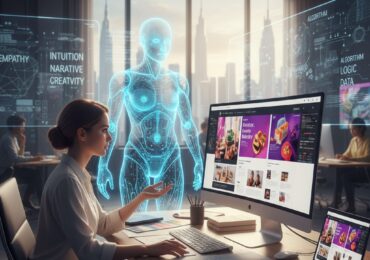If you spend any time in the digital world, you’ve probably seen how fast AI tools have been popping up. Some folks are excited about it and others get a little nervous, especially people who work in creative fields. Web designers tend to sit somewhere in the middle. They use AI when it makes their work easier, but they also know something that the headlines often miss. Good web design is far more than plugging words and images into a template. It’s a blend of strategy, visual communication, psychology, and a whole lot of human intuition. AI might be powerful, but it can’t quite replicate all of that.
Let’s talk about why.
Websites Need Personality, Not Just Layouts
You can ask an AI tool to make a website layout and it might give you something clean and functional. The problem is that most brands want more than functional. They want personality. A bakery in Oregon wants its warm, cozy vibe to shine through. A tech startup in New York wants modern grit with sleek polished lines. That’s where human designers bring something unique to the table. They understand mood, tone, culture, and story in a way machines just can’t.
People respond emotionally to design. They might not always know why they like a site, but they feel it. Creating that kind of emotional connection takes empathy and a deep understanding of how humans move through digital spaces. AI can get close, but it often misses the little quirks that make a site unforgettable.
Real Brands Need Real Problem Solvers
AI is great at producing options quickly, which is handy. But it isn’t built to handle messy, real world situations in the same way a human can. Maybe a client wants to combine an online store with booking tools. Maybe they want pages arranged in a way that doesn’t fit typical patterns. Or maybe they want something that seems simple at first but becomes more complicated the moment you open the settings.
Human web designers spend a lot of time troubleshooting weird problems, smoothing out user flows, and combining tech tools that weren’t built to live together. This kind of work needs creative, flexible thinking. It also needs someone who can talk clients through their ideas and gently steer them toward what will actually work. AI doesn’t hold client meetings or spot a problem before it becomes one.
Design Trends Change Fast
Another reason designers are still essential is that the digital world never stays still. Trends come and go, and people aren’t drawn to the same visuals year after year. Human designers pay attention to what feels fresh, what feels tired, and what’s starting to bubble up in the design world. AI tools often pull from huge pools of existing data, which means they sometimes lean on patterns that already feel dated.
A good designer knows when to push boundaries and when to stick with something more classic. They also know how to mix trends with brand personality, which keeps a site looking stylish without becoming hard to use.
A Future with Both Humans and AI
There’s no doubt that AI will continue to shape the web design world. It already helps with wireframes, content suggestions, color palettes, and more. Many designers choose to strengthen their skills with formal training such as an online web design degree, which can help them use both tech and creativity in smarter ways. But even with all that progress, AI simply can’t replicate human imagination or the ability to understand a brand at its emotional core.
In the end, the future isn’t humans versus machines. It’s humans using smart tools to make even better work. And in that future, web designers aren’t going anywhere.
